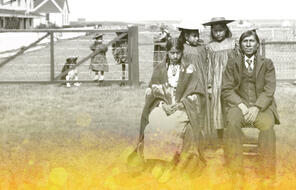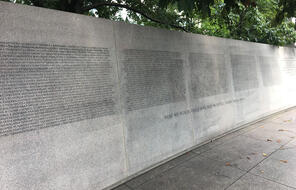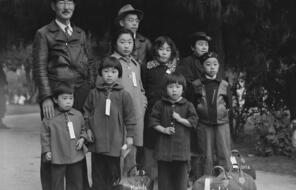Feathers of Hope
In March 2013, the Feathers of Hope Youth Forum took place in Thunder Bay, Ontario. More than 100 youth from 62 northern indigenous communities participated by sharing their “lived experiences” and talking about “issues affecting their lives” in Northern Ontario. On the last day of the forum, the young participants presented what became its publication, Feathers of Hope: A First Nations Youth Action Plan, to a group of community and government leaders.
The plan strived to address the legacy of colonialism and residential schools within their own communities while discussing larger issues of mental and physical health, substance abuse, and the tragedy of youth suicide. It also addressed the importance of strengthening First Nations teachings, culture, identity, and education through the healing and growing process. The plan also tackled such practical issues such as finding sustainable funding and community role models and mentors for continued activism, and how to build a movement. These young activists pointed, first and foremost, to the importance of indigenous youth leadership in building a sustainable movement to strengthen their communities and cultures for future generations. Recommendations were made by the forum on all of these issues under the heading “Taking Steps to Make Hope Real.”
Goals and Activism
The poverty and “conditions of hopelessness” faced by some of the indigenous communities in Northern Ontario motivated the five young people who, in their roles as “Youth Amplifiers” for the Ontario Office of the Provincial Advocate for Children & Youth, organized the forum over a period of almost two years. At the forum’s conclusion, they stated:
The Feathers of Hope forum process showed that partnerships that support safe space and respect, allow young people to speak powerfully and passionately about their determination to achieve change. This is, in essence, why this project is so important to us. First Nations youth deserve better than the lives of neglect and marginalization we have been forced to live due to the failure of government, First Nations leadership and consequently our communities to meet our most basic needs. . . . Feathers of Hope helped young people realize they could share their feelings and experiences, talk about their wants and needs, dreams and hopes for the future, and add their voices and energies to work with their communities, leadership and government to create real change. 1
In total, the plan summarized the diverse experiences and perspectives of more than 175 youth living on-reserve in Northern Ontario. This revealed a strong desire to move forward and grow alongside their cultures and communities:
We feel like we have a foot in two worlds—the modern and the traditional—and yet we are disconnected from both. The residential schools have disconnected many of us from our histories and our treaties. We want to speak our languages. We want to have a deeper connection to the land, our traditions, communities and elders and live in communities where we can give back and help one another. These things are important because they strengthen our sense of identity as First Nations young people. But we are more than this; we are also modern, wanting the education and post-secondary experiences of non-First Nations people. We are young people wanting access to opportunity and success. 2
The plan made many recommendations on many topics, including those addressing the legacy of the residential schools. These focused on dispelling myths by striving to do the following:
- Establish a nationally recognized day that commemorates the lives stolen by residential schools and the impacts the schools continue to have in the lives of First Nations young people, adults and elders.
- Establish a First Nations History Month (like Black History Month).
- Design and implement, with the input of First Nations youth, curriculum that teaches the truth about what happened in residential schools, day schools and the Sixties Scoop to counteract the harmful stereotypes and false and misleading “debates” that play out in the media.
- Establish partnerships and scholarships for First Nations young people to promote access to broadcasting and media resources and help create real First Nations content.
- Fund the establishment of more networks like the Aboriginal Peoples Television Network, and cover the issues of importance to Aboriginal peoples in all our diversity.
- Make the publication of blatantly racist articles in the media subject to “hate laws.”
- Begin with families. We need families to have the support necessary to begin healing. 3
Overall, the Feathers of Hope Youth Action Plan encouraged engaged and community-based youth activism focusing on the “importance and power of hope.” Acknowledging that there are “no quick fixes to the challenges facing First Nations children and youth, their family and communities,” the plan offered steps “that can be followed to start a change process focused on improving our lives and healing our communities.”
Connection Questions
- How do the activists behind the Feathers of Hope Youth Action Plan describe their goals? What role does identity play?
- As you read their action plan, which items feel most important to you?
- How do you define your community? What challenges does your community face? If you were to make an action plan for your community, what would it include? What kind of activism do you think would help engage people with these issues positively?
- 1“Letter from the Youth Amplifiers,” in Together We Are...Feathers of Hope: A First Nations Youth Action Plan (Provincial Advocate for Children and Youth, 2014), 10-11, Canadian Child Welfare Research Portal. Reproduced by permission of Provincial Advocate for Children and Youth, 2014.
- on-reserveSince the beginning of the reserve system in the 1830s, many First Nations people have resided on reserves in Canada. Historically, reserves served as “social laboratories” where First Nations inhabitants were to become productive, “civilized,” Christianized, and assimilated into the settlers’ ways of life. There is a growing population of people who live “off-reserve” in urban or simply non-reserve locations. Over the years, many reserves have transitioned into relatively autonomous self-governed communities. The most recent Canadian census reveals that just over 50% of First Nations individuals registered as Status Indians reside off-reserve.
- 2“Executive Summary,” in Together We Are...Feathers of Hope: A First Nations Youth Action Plan (Provincial Advocate for Children and Youth, 2014), 13, Canadian Child Welfare Research Portal. Reproduced by permission of Provincial Advocate for Children and Youth, 2014.
- day schoolsAlongside residential schools and industrial schools, day schools were part of the residential school system for indigenous children in Canada. Often located on the reserves, these schools served about two-thirds of indigenous students throughout the history of the system. They were operated by both municipal authorities and the churches, and they attempted to reach the same goals as the Indian Residential Schools: Christianization and assimilation. Many of the troubles and abuses found in the residential schools were also found in the day schools.
- AboriginalStemming from the mid-seventeenth-century Latin term aborigines, meaning “original inhabitants,” Aboriginal is the preferred legal term in Canada for the large and diverse grouping of First Nation, Métis, and Inuit nations. It is used synonymously with the term indigenous in various parts of Canada.
- 3"Taking Steps to Make Hope Real,” in Together We Are...Feathers of Hope: A First Nations Youth Action Plan (Provincial Advocate for Children and Youth, 2014), 34, Inspiration Foundation website. Reproduced by permission of Provincial Advocate for Children and Youth, 2014.
How to Cite This Reading
Facing History & Ourselves, "Feathers of Hope," last updated October 29, 2019.















